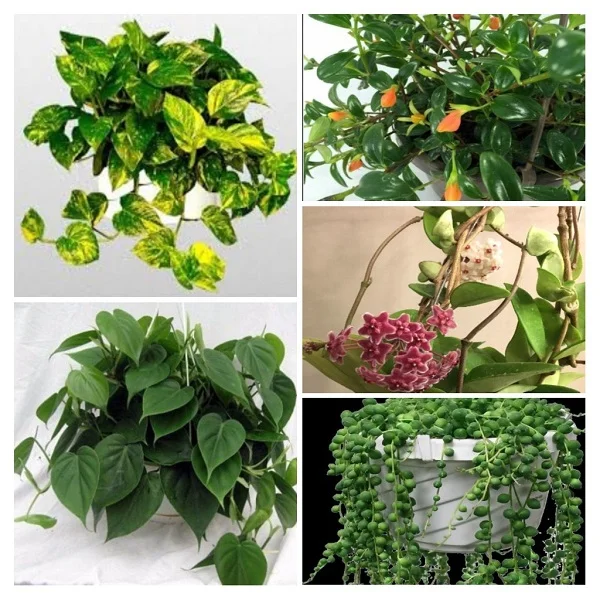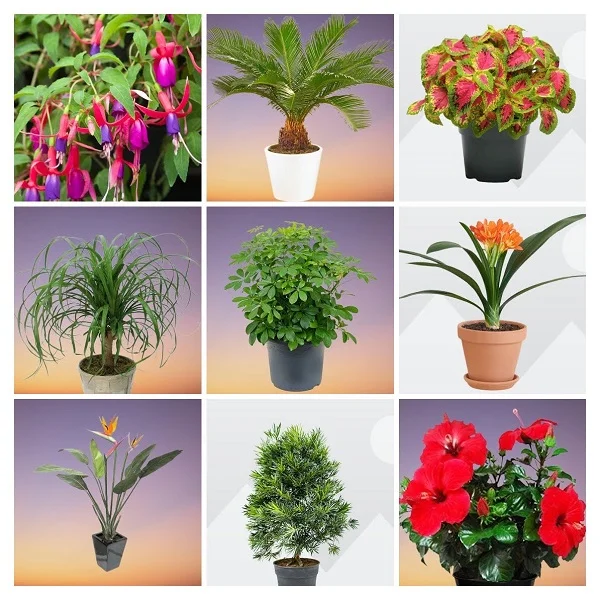Pink Jasmine (Jasminum polyanthum) Indoor Care, Propagation, Problems and Solutions
Some links in this post may be affiliate links
Pink Jasmine (Jasminum polyanthum) grows best in bright light with some direct sunlight, average warmth, moderate humidity and consistently moist, rich, well-drained, all purpose potting soil coupled with fortnightly feeding in the growing season.
Although Jasminum polyanthum is relatively easy-care, it requires the right balance of light, water, and humidity to flourish. In this guide, we cover indoor care tips, propagation methods, common problems, and their remedies to help your Pink Jasmine stay vibrant and healthy. Before we dive into care tips, let's get an overview of this plant.
Jasminum polyanthum also called Winter Jasmine, Star Jasmine, French Perfume or Chinese Jasmine is among the popular flowering plants on account of its characteristic, fragrant flowers which occur in clusters and its resistance to pests and diseases.
There are several Jasmines that can be grown as in the home. The most popular ones have white blooms with a delicious fragrance. The easiest to grow is Jasminum polyanthum, (Pink Jasmine) whose pale rosy buds open into starry, white flowers borne in groups of 20 or more.
The species name, 'polyanthum', means many-flowered in reference to the numerous starry white flowers which also give this plant the common name, 'Manyflowered Jasmine'.
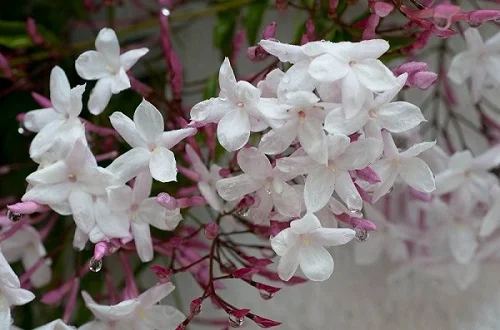
Botanical name: Jasminum polyanthum
Family: Oleaceae
Common names: Pink Jasmine, Winter Jasmine, Star Jasmine, French Perfume, Chinese Jasmine, Manyflowered Jasmine
Origin
Jasminum polyanthum (Pink Jasmine) is native to southeastern China.
Size
Chinese Jasmine is a vigorous climber whose stems can reach 10 feet if left unpruned. It can be grown on a trellis, in a hanging basket or even on a fence where the stems can grow freely. It is one of the best flowering plants for hanging baskets.
Related Jasminum Plants
Jasminum officinale, (White Jasmine) is another common Jasmine that can be grown indoors. It bears twining stems, much divided leaves and long-tubular, white flowers with a strong fragrance.
Jasminum primulinum, (Primrose Jasmine) is the odd one out in that the yellow flowers are non-fragrant, and the stems do not twine. The flowers are semi-double with 6 or more petals.
Is Pink Jasmine toxic to pets?
Pink Jasmine plants are non-toxic to humans and pets as indicated by ASPCA. Pink Jamine plants are safe for cats, dogs and other pests.
Where to Buy
If you are looking to add these plants to your collection, Pink Jasmine plants are available online on Etsy (Link to Etsy).
Caring for Jasminum polyanthum indoors
To care for Jasminum polyanthum, provide bright light with 4-6 hours of direct sunlight, average warmth of 18-240C, moderate humidity of 50-55% and consistently moist, rich, well-drained potting soil coupled with fortnightly feeding during the growing season.
Pink Jasmine has no need for frequent repotting as it blooms best when pot-bound. Regular pruning is necessary to keep it neat and also encourage a bushy growth. Keep reading for more on these growing conditions and how to provide them.
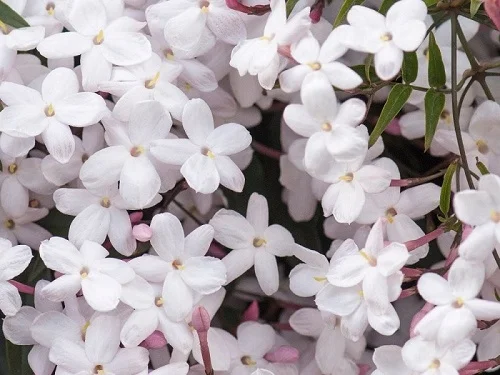
Watering
Water your Pink Jasmine thoroughly during the growing season while allowing the top 1-2 inches of soil to dry out between waterings. Keep the soil consistently but not soggy to avoid yellow leaves and rotting stems.
Cut down on watering in the cold period (fall and winter) as growth is reduced at this time. Do not allow the soil to dry out completely to prevent dry, crispy leaves and stunted growth..
Ensure the pot has a drainage hole to avoid getting soggy soil as it can lead to root-rot and eventual death of the plant.
Light Requirements
Pink Jasmine thrives in bright light with at least 4-6 hours of morning or late afternoon sunshine; a spot infront of a large, brightly-lit window.
It will not bloom if the light is not enough. Therefore, where the natural lighting is too low, consider using grow lights to supplement it.
Pro tip: Regularly turn the pot to ensure the plant receives adequate light on all sides to promote even growth and prevent the plant from getting leggy.
Temperature and Humidity
Pink Jasmine blossoms in an average warmth of 18-240C during the growing season. Keep it cool at about 150C during the dormancy period (cold season).
Keep Winter Jasmine away from drafts to prevent sudden changes in temperatures which can cause reduced growth and leaf drop.
Pink Jasmine has no need for extra humidity; average room humidity of 50-55% is ideal for this plant. However, if the air is too dry, the plant will respond with curling leaves. Set the pot on a wet pebble tray to raise humidity or grow the plant in a well-lit bathroom and other moist areas in the home.
Pro tip: Ascertain that there is good air flow for your plant to discourage fungal diseases.
Fertilizer
Feed your Pink Jasmine with a phosphorous-rich, water-soluble fertilizer every 2-3 weeks during the growing season to promote flowering. Avoid toouch fertilizer as it can lead to leggy growth. Do not feed in the cold season as growth is minimal at this time.
Potting Mix
The best potting medium for Pink Jasmine should be a well-draining, fertile soil. A mix of 50% potting soil, 30% perlite or sand and 20% peat moss or coco coir ideal for this plant.
Repotting
Repot Pink Jasmine once a year at the beginning of the growing season only when the plant is extremely root-bound as it blooms best when slightly pot-bound.
Use a pot 1 size larger than the current one and one that has a drainage hole to prevent the soil from becoming soggy as it can lead to root-rot. Check out these pots with drainage holes on Amazon.
Pruning & Grooming
Pruning Pink Jasmine is easy:
- Remove dead flowers and leaves to maintain the plant tidy as well as discourage pests and diseases.
- Pinch off the growing tips to encourage compact growth and prevent the plant from getting unruly.
- After flowering, cutback the stems to rejuvenate growth and to keep the plant compact.
Regularly clean the leaves by damp-wiping with a soft cloth to get rid of dust and also minimize pests and diseases infestations.
Pro tip: Use sterilized pruning scissors to avoid spreading diseases among your plants.
Jasminum polyanthum Propagation
Jasminum polyanthum (Pink Jasmine) propagation can be done at the beginning of the growing season from stem cuttings.
Propagating Pink Jasmine from stem cuttings
- With clean, sharp pruning scissors, take a 4-5 inches stem cuttings from a healthy plant and strip off the lower leaves.
- Select a 6 or 8 inches pot and ensure that the pot has a drainage hole to prevent the soil from getting soggy to avoid rotting.
- Fill the pot with well-drained, potting mix and moisten the soil slightly.
- Make a hole in the center of the pot and ensure it is wider that the base of the cutting.
- Insert 2 inches of the lower cut end of the cuttings in the hole made above and lightly firm the soil around.
- Place the set up in a warm, well-lit spot away from direct sunlight.
- Maintain the soil moist through out until the new plants are well established.
- Once the new plants are well established transplant into pots one size larger after which you can begin routine care.
Pro tip: For a fuller plant, transfer several cuttings into one pot.
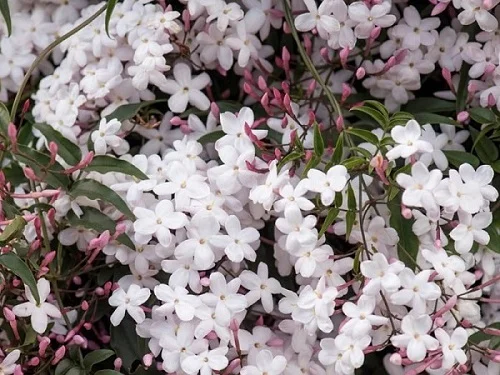
Jasminum polyanthum Problems & Remedies
Pink Jasmine (Jasminum polyanthum) problems include plant dying, brown leaves, yellow leaves, dropping leaves, flowerbud drop, lack of blooms (flowers), curling leaves, pests and diseases. Keep reading for more on these problems and how to fix them.
Plant dying
Why is my Pink Jasmine dying?
Your Pink Jasmine is dying due to root-rot which is prevalent in soggy soil. It is characterized by yellowing and wilting of the leaves which is rapidly followed by browning and plant collapse.
How to revive Pink Jasmine
- Carefully remove the plant from its pot and inspect the roots.
- Trim brown-black, mushy roots and treat the healthy roots with a copper-based fungicidal solution. Ensure to follow the manufacturer's directions on the label.
- Disinfect the pot with the fungicidal solution or use a fresh pot to repot the plant in fresh well-draining soil.
- Do not water the plant and keep it dry for some time before resuming watering
- To prevent root-rot in the future, ascertain that the pot has a drainage hole and the soil is free-draining.
- Cut down on watering in fall and winter as growth is reduced at this time to maintain the soil slightly moist.
Lack blooms (flowers)
Why is my Pink Jasmine not blooming?
Your Jasminum polyanthum is not flowering due to little light and wrong fertilizer.
How to fix it
- Little light: Position the plant in a brighter spot and ensure it is receiving bright light with at least 4-6 hours of direct sunlight or instal a grow light where natural lighting is not sufficient.
- Wrong fertilizer: Do not feed with a Nitrogen-rich fertilizer as it promotes foliage growth at the expense of flowers. Feed every 2-3 weeks during the growing season with a phosphorous-rich fertilizer.
Dropping flowerbuds
Why do Pink Jasmine flowers fall off so quickly?
Dropping flowerbuds in Pink Jasmine is caused by underwatering, underfeeding, and temperature stress.
How to fix it
- Underwatering: Maintain the soil consistently moist during the growing season and slightly moist in the cold season but never allow the soil to dry out completely.
- Underfeeding: Feed every 2-3 weeks in spring and summer with a phosphorous-rich, water-soluble fertilizer.
- Temperature stress: Keep the plant away from drafts to maintain an average warmth of 18-240C.
Brown leaves
Why are the leaves of my Pink Jasmine turning brown?
Some of the causes of brown leaves on your Pink Jasmine are are incorrect watering, soggy soil, temperature stress, hot direct sunlight, and overfertilizing.
How to fix it
- Incorrect watering: Water only when top few inches of soil feel dry to the touch. Never let the soil dry out completely.
- Soggy soil: Use a well-drained soil and a pot that has a drainage hole.
- Temperature stress: Keep the plant away from drafts emanating from AC units, windy doors, stoves and others.
- Direct sunlight: Keep the plant away from hot direct sunlight to avoid scorching.
- Overfertilizing: Feed every 2-3 weeks in the growing season.
Yellowing leaves
Why is my Pink Jasmine turning yellow?
Some of the causes of yellow leaves on your Pink Jasmine are overwatering, soggy soil, and low light.
How to fix it
- Overwatering: Do not water on a schedule. Water only when the top 1-2 inches feel dry.
- Soggy soil: Ensure to use soil that is free-draining and a pot that has a drainage hole.
- Low light: Position the plant infront of a large bright window or use a grow light to supplement insufficient natural light.
Dropping leaves
Why is my Pink Jasmine losing leaves?
Dropping leaves (leaf fall) in Pink Jasmine is caused by overwatering, underwatering, and temperature stress.
How to fix it
- Overwatering: Water when the top 1-2 inches of soil dry out to maintain the soil consistently moist but not soggy.
- Underwatering: Never allow the soil ball to dry out completely.
- Keep the plant away from cold drafts like breezy windows and doors to maintain an average warmth 18-240C.
Leggy growth
Leggy growth in Pink Jasmine is due to little light and too much fertilizer. Give the plant bright light with some morning sunshine and take care not to overfertilize.
Curling leaves
Curling leaves on Pink Jasmine are due to dry air. To elevate humidity, set the pot on a wet pebble tray, use a humidifier or group the plants together to create a humid microclimate.
Pests
Pink Jasmine is prone to aphids and spider mites. Isolate the affected plant to prevent spread to other houseplants and treat it with neem oil or insecticidal soap as directed by the manufacturers.
Diseases
Pink Jasmine diseases are related to poor cultural practices. The common diseases are leaf spot and leaf rust. Isolate the affected plant to prevent spread to other plants and treat it with insecticidal soap.
Conclusion
Pink Jasmine (Jasminum polyanthum) is a rewarding indoor plant that fills your home with lush greenery and fragrant blooms. With the right balance of light, water, and nutrients, your Jasmine will thrive and bloom year after year.
By following these care tips, propagation methods, and troubleshooting solutions, you can enjoy the beauty of this elegant plant while keeping it healthy and vibrant indoors.
Frequently Asked Questions
1. How often should I water my Pink Jasmine indoors?
Do not water on a schedule. Water Pink Jasmine when the top 1-2 inches of soil feel dry to the touch.
2. Can Pink Jasmine survive in low light?
No, Pink Jasmine requires at least 4-6 hours of bright sunlight to bloom well.
3. How do I make my Pink Jasmine grow fuller and bushier?
Regular pruning and pinching back tips encourage a compact, bushy growth.
4. What is the best fertilizer for Pink Jasmine?
The best fertilizer for Pink Jasmine is phosphorous-rich to boost flowering.
5. Does Jasminum polyanthum smell?
Jasminum polyanthum bears large clusters of strong, sweet-scented white flowers.
6. What is the difference between Jasminum officinale and Jasminum polyanthum?
Jasminum officinale (White Jasmine) bears long-tubular, white flowers with a strong fragrance while Jasminum polyanthum (Pink Jasmine) bears star-shaped, white flowers with a strong, sweet-scented smell which appear in pink buds.
You liked it? Share on social media.
Related Content
Amazon Associates Disclosure
Homeplantsguide.com is a participant in the Amazon Services LLC Associates Program, an affiliate advertising program designed to provide a means for sites to earn advertising fees by advertising and linking to amazon.com.



